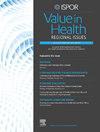在马来西亚,血管紧张素受体Neprilysin抑制剂与血管紧张素转换酶抑制剂在射血分数降低的心力衰竭患者中的成本-效果分析
IF 1.4
Q3 HEALTH CARE SCIENCES & SERVICES
引用次数: 0
摘要
目的:从马来西亚卫生部的角度比较了血管紧张素受体neprilysin抑制剂(ARNI)和血管紧张素转换酶抑制剂(ACEI)治疗心力衰竭射血分数降低人群的成本和效果。方法构建以月为周期的三状态马尔可夫模型,估计ARNI和ACEI的终生医疗成本、质量调整生命年(QALY)和增量成本-效果比(ICER)。全因死亡率和心力衰竭(HF)住院的每月基线风险从PARADIGM-HF试验中估计,并对马来西亚人群进行年龄调整。治疗效果由PARADIGM-HF试验获得。由住院、效用价值和费用引起的全因死亡率风险来源于当地研究。所有费用调整到2023年。ICER与马来西亚林吉特(rm55 426) / QALY(人均国内生产总值)进行比较。结果尽管ARNI比ACEI更昂贵,但它获得了更多的QALY,导致每个QALY的ICER为RM46 498。单向敏感性分析发现,关键的模型驱动因素是对心血管死亡率的相对治疗效果、治疗效果持续时间和时间范围。概率敏感性分析估计ARNI在每个QALY RM55 426的成本效益阈值下具有66%的成本效益。亚组分析显示ICER随年龄增长而增加。情景分析表明,与钠-葡萄糖共转运蛋白-2抑制剂(SGLT-2i)一起启动ARNI可以产生更有利的ICER,而没有SGLT-2i的ARNI则可以产生更有利的ICER。结论在每QALY 55426 rm1的成本-效果阈值下,对于心力衰竭伴射血分数降低人群,ARNI比ACEI更具成本效益。扩大患者获得ARNI的机会可能会经济有效地改善健康结果。本文章由计算机程序翻译,如有差异,请以英文原文为准。
Cost-Effectiveness Analysis of Angiotensin Receptor Neprilysin Inhibitor Compared With Angiotensin-Converting Enzyme Inhibitor Among Patients With Heart Failure With Reduced Ejection Fraction in Malaysia
Objectives
This study compared the costs and effectiveness of angiotensin receptor neprilysin inhibitor (ARNI) with angiotensin-converting enzyme inhibitor (ACEI) for the heart failure with reduced ejection fraction population from the Malaysian Ministry of Health’s perspective.
Methods
A 3-state Markov model, with a monthly cycle, was constructed to estimate the lifetime healthcare costs, quality-adjusted life year (QALY), and incremental cost-effectiveness ratio (ICER) of ARNI and ACEI. The monthly baseline risks for all-cause mortality and heart failure (HF) hospitalization were estimated from the PARADIGM-HF trial and age-adjusted to the Malaysian population. The treatment effects were obtained from the PARADIGM-HF trial. All-cause mortality risks from hospitalization, utility values, and costs were derived from local studies. All costs were adjusted to 2023. The ICER was compared with Malaysian Ringgit (RM) 55 426 per QALY (one gross domestic product per capita).
Results
Despite ARNI being more expensive compared with ACEI, it gained more QALYs, resulting in an ICER of RM46 498 per QALY. One-way sensitivity analyses found that the key model drivers were the relative treatment effects on cardiovascular mortality, duration of treatment effects, and time horizon. Probabilistic sensitivity analysis estimated that ARNI is 66% cost-effective at the cost-effectiveness threshold of RM55 426 per QALY. Subgroup analysis showed that ICER increased with age. Scenario analysis demonstrated that initiation of ARNI alongside sodium-glucose cotransporter-2 inhibitor (SGLT-2i) produces more favorable ICER and ARNI without SGLT-2i.
Conclusions
At the cost-effectiveness threshold of RM55 426 per QALY, ARNI is cost-effective compared with ACEI for the heart failure with reduced ejection fraction population. Expanding patient access to ARNI is likely to improve health outcomes cost-effectively.
求助全文
通过发布文献求助,成功后即可免费获取论文全文。
去求助
来源期刊

Value in health regional issues
Pharmacology, Toxicology and Pharmaceutics-Pharmacology, Toxicology and Pharmaceutics (miscellaneous)
CiteScore
2.60
自引率
5.00%
发文量
127
 求助内容:
求助内容: 应助结果提醒方式:
应助结果提醒方式:


